

ART PICS: Artist’s nude self-portrait drawn by robotic printer in his own blood! From Brooklyn-based artist Ted Lawson‘s ‘Ghost in the machine’ is a life-sized, nude self-portrait rendered from his own bodily fluid.
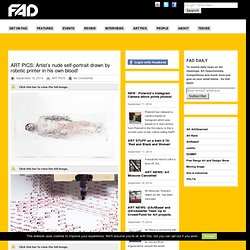
Fed intravenously to a CNC machine, Lawson’s blood traverses through the mechanical parts, while a robotic arm attached to the device — programmed to trace the designated illustration — carefully maps out the human form. Via: designboom In this series I’m really just trying to make a good drawing, which requires a lot of process and spontaneity to achieve. Watch The Trailer For Chris Mars' Grotesque Animated Short IN HANFORD. Virginia Mori, between innocence and grotesque. Born in Cattolica in 1981 and currently living and working in Pesaro, Italian artist Virginia Mori studied Illustration and Animation at the National Art Institute of Urbino, improving her artistic imagery and creating traditional animation shortcuts.
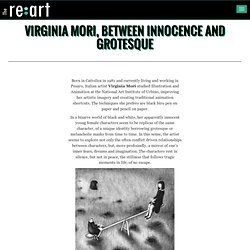
The techniques she prefers are black biro pen on paper and pencil on paper. In a bizarre world of black and white, her apparently innocent young female characters seem to be replicas of the same character, of a unique identity borrowing grotesque or melancholic masks from time to time. In this sense, the artist seems to explore not only the often conflict driven relationships between characters, but, more profoundly, a mirror of one’s inner fears, dreams and imagination. The characters rest in silence, but not in peace, the stillness that follows tragic moments in life, of no escape.
Animated Films. Early Animation: The inventor of the viewing device called a praxinoscope (1877) , French scientist Charles-Emile Reynaud, became known as the First Motion Picture Cartoonist.

He had created a large-scale system called Theatre Optique (1888) (aka "optical theatre") which could take a strip of pictures or images and project them onto a screen. He demonstrated his system in 1892 for Paris' Musee Grevin - it was the first instance of projected animated cartoon films (the entire triple-bill showing was called Pantomimes Lumineuses), with three short films (each approx. 10-15 minutes in length) that he had produced, in order: To create the animations, individually-created images were painted directly onto the frames of a flexible strip of transparent gelatine (with film perforations on the edges), and run through his projection system.
Depending upon one's definition of terms, some consider Pauvre Pierrot the oldest-surviving animated film ever made and publically broadcast. Reality Is Horrific Enough: an interview with filmmaker Nick Cross. He day begins like any other: the sun rises, the rooster crows, the farmer jumps out of his bed and into his boots to greet the new dawn.
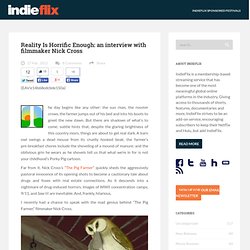
But there are shadows of what’s to come; subtle hints that, despite the glaring brightness of this country morn, things are about to get real dark. A barn owl swings a dead mouse from its cruelly hooked beak; the farmer’s pre-breakfast chores include the shoveling of a mound of manure; and the oblivious grin he wears as he shovels tell us that what we’re in for is not your childhood’s Porky Pig cartoon. Far from it. Sadie Benning Videoworks: Volume 1. A compilation of five of Sadie Benning’s early works.
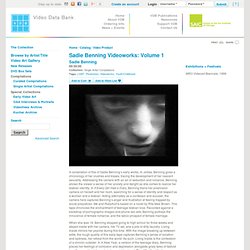
In Jollies, Benning gives a chronology of her crushes and kisses, tracing the development of her nascent sexuality. Addressing the camera with an air of seduction and romance, Benning allows the viewer a sense of her anxiety and delight as she comes to realize her lesbian identity. In If Every Girl Had a Diary, Benning trains her pixelvision camera on herself and her room, searching for a sense of identity and respect as a woman and a lesbian. Acting alternately as a confessor and accuser, the camera here captures Benning’s anger and frustration at feeling trapped by social prejudices. Me and Rubyfruit is based on a novel by Rita Mae Brown. Images over time. What do we mean by motion graphics?
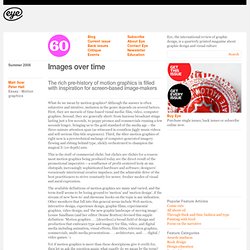
Although the answer is often subjective and intuitive, inclusion in the genre depends on several factors. First, they are morsels of time-based visual media: film, video, computer graphics. Second, they are generally short: from luscious broadcast stings lasting just a few seconds, to peppy promos and commercials running a few seconds longer, bringing us to the gold standard of the media age – the three-minute attention span (as witnessed in countless jiggly music videos and self-serious film title sequences). Title sequences from Saul Bass, the master of film title design by Matt Linderman of Basecamp. 10 Disturbing Animated Shorts That Will Give You Nightmares. Creepy Animation is a fantastic visual medium.
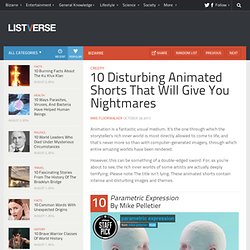
It’s the one through which the storyteller’s rich inner world is most directly allowed to come to life, and that’s never more so than with computer-generated imagery, through which entire amazing worlds have been rendered. However, this can be something of a double-edged sword. For, as you’re about to see, the rich inner worlds of some artists are actually deeply terrifying. Vi Hart’s Playful Mathematics: Flatland on a Möbius Strip. Saul Bass: A Life in Film & Design. By Maria Popova The much-awaited monumental monograph of the greatest graphic designer of all time.

Saul Bass (1920-1996) is one of the most iconic and influential visual communicators of the 20th century — possibly the most famous graphic designer of all time — having broken out of the conformity of the 1950s to shape the aesthetic of generations of designers and animators with his bold and lively film title sequences and graphic design. (His insights on creativity and advice on doing quality work are also a timeless treat for any creator.) Yet no definitive monograph of his prolific, monumental work has existed — until now. I want everything we do to be beautiful. Why Man Creates: A Saul Bass Gem from 1968. By Maria Popova I love iconic graphic designer Saul Bass and have a soft spot for luminaries’ musings on the nature of creativity.

Naturally, I’m head over heels with Why Man Creates — a remarkable short documentary from 1968, animated by Bass and alluringly subtitled “a series of explorations, episodes & comments on creativity.” Playful yet profound, the film is a series of sequences that at first appear unconnected but eventually converge into a compelling exploration of (wo)man’s most fundamental impetus to create, featuring such delightful tongue-in-cheek vehicles as this exchange between Michelangelo and da Vinci: Whaddaya doin?” ‘I’m painting the ceiling! Construction Cinema. Once bare-bones and utilitarian, architectural animation is becoming more nuanced and experiential.

In part, this development can be credited to advances in 3-D technology, but at the same time architects have embraced the art of filmmaking -- not only to create more interactive presentations for clients, but also to leverage as a tool in the design process. It’s easy to think of architecture as an interdisciplinary field. At its most basic level, art and science combine to create buildings that are both beautiful and functional. In much the same way, architects are now relying on a broad spectrum of professional fields for sharing their work. From film to video games to documentary photography, architects are stretching beyond their own circles to present and explain their projects in new and even entertaining ways.
Just Imagine (1947) Hey download generation, your future is up on YouTube. The explosion of online content creation is one of the contemporary wonders of the world but where is the Australian content? Asks Stuart Cunningham. User-generated content (UGC) and their applications are by far the largest type of online content, both now and in any foreseeable future. The latest guesstimate on US online content suggests that more than 70% of the digital universe is generated by users – individuals at home, at work, and on the go. That’s 880 billion gigabytes! But this flowering of creativity is not met with unalloyed enthusiasm. The vast and growing phenomenon of UGC suggests significant dissatisfaction with what mainstream media is offering, particularly among digital natives who have grown up with the net. And the way is it rapidly being monetised can also be seen as threat to established business models in the creative sector.
AFI Film Readers : Pervasive Animation. EBL Reader - Controversial Images : Media Representations on the Edge. Literature Criticism Interview by Clive Barker and Paul Wells. Interview by Clive Barker and Paul Wells SOURCE: Barker, Clive, and Paul Wells. “On the Side of the Demons: Clive Barker's Pleasures and Pains.” In British Horror Cinema, edited by Steve Chibnall and Julian Petley, pp. 172-82. London: Routledge, 2002. In the following excerpt, Wells presents highlights from his conversations with Barker in which the author summarizes his literary preoccupations.
Clive Barker, novelist, artist, writer and director, has already achieved considerable success in two major aspects of the horror genre. Colourful Claims: towards a theory of animated documentary. By Jonathan Rozenkrantz. Every film is a documentary. (Bill Nichols 2001) There is no such thing as documentary [...]. (Trinh T. Minh-ha 1993) Why bother?
Taken out of their contexts, Bill Nichols’ and Trinh T. How ‘true’, then, is animation? Animation Evolution: death and animation. It’s Raining Coyotes: Death and/in the Chase(preconstituted panel: At Death’s Insistence: Theorising Animation and Death) Abstract: In s urveying a number of American cartoons during the post-World War II era, this paper seeks to demonstrate the ways in which popular animation engages in an aporetical uncertainty, focusing primarily on the investiture of sapience into the cartoon character, the existential connotations of the chase, and the “death confrontation” signified by the blackout gag. The motifs of acknowledgment and “deceleration” in the cartoons of the era will be addressed: how does this phenomenology of the personified form produce this effect?
CGI Animation and History. The representation of history on television and in the cinema have traditionally been divided into two separate genres, the dramatic and the documentary - by implication the fictional and the factual respectively, but as Jane Gaines has suggested, with the advent of new digital technologies these ‘old distinctions’ would appear to be ‘no longer viable’. Similarly, Scott and White argue that the Walking with Dinosaurs series draws upon, ‘already existing forms of televisual and filmic representation [refashioning] them via digital technology to produce a new kind of hybrid genre. This article considers the implications of the making of historical programmes in this way, and the possibility of these texts being consumed as ‘preferred’ visual history. Representations of 'the real' Computer generated films that completely replace live action may still be in their infancy.
Rooftop Cinema brings experimental animation to MMOCA in June. Book review: The World History of Animation. EBL Reader - Animated Documentary. Animation and robotics: Crossing the uncanny valley. Animation and critical theory by Alla Gadassik. Senecio by Paul Klee: Leslie draws links between early animation and various modernist painting traditions, noting that they often shared aesthetic concerns, political aspirations, and artists who worked both in painting and animation. Panic Button Pictures. 25 great stop-motion moments in live-action films. From the early 20th century to its close, stop motion animation was a common method of making the impossible seem tangibly real. And while stop motion is still a beloved artform , as seen in this year's Frankenweenie (which ranked highly on our top 10 list of such animated movies) the advent of computers has seen its use in live-action films dwindle to a dot. This list is devoted to some of the most magical, surprising and occasionally horrifying stop motion animated moments in live-action films.
From dinosaurs to skeletons to trigger-happy robots, animators such as Willis O'Brien, Ray Harryhausen and Phil Tippett, to name a few, have captivated audiences everywhere. Expanding ideas about animation. Diasynchronoscope Project. AnimateTV – 20 Years of Experimental Animation from the UK – Teaser. The History of Experimental Animation. Expanding ideas about animation. » Page 2. I’m happy to announce that on Saturday, August 3rd, you’ll have a chance to see the second program of animated shorts I’ve curated. These are also all by members of the Seattle Experimental Animation Team, and this time around they all have animal/nature themes. Ten films by seven artists (including Bruce Bickford!) Pre-Cinema Project - it will all be okay.
Alan Cholodenko – (The) Death (of) the Animator, or: the Felicity of Felix, Part I. From 19th Century Print Cartoon to 20th Century Animated Cartoon - How Caricaturists Shaped Early Animated Film. A Film of One’s Own: The Animated Self-Portraits of Young Contemporary Female Animators. Self-representation of authors eventually fashioned a cliché for cartooncomedy, where the animator interacted with his drawn creature in aheterogeneous environment still applicable to later movies, like Guido Manuli‘s Solo un bacio (1983).
Animation and critical theory by Alla Gadassik. Animating Documentary.
What of animation and (T)theory. Week 3. Week 2. Week 1. Pervasive Animation Matters: From the Arts and Work to the Everyday - Professor Suzanne Buchan. BIG BANG BIG BOOM - the new wall-painted animation by BLU. Animation Theory vs. Theories of Animation. A couple of weeks ago, I responded to an excellent post by Caroline Ruddell in which she asks ‘what of animation theory?’ I suggested that animation studies hasn’t cohered around any central questions of enquiry in the way Film Studies did and this might be a reason for the perceived aversion to, or even lack of, ‘animation theory’.
My response was off-the-cuff, but since then I’ve continued to ponder these two suggestions regarding cohesion in, and aversion to, animation theory. I do think it’s true that animation studies never coalesced around a single question, or questions, of enquiry in the way that early Film Studies did. To reduce things overly simplistically and teleologically, Film Studies ‘evolved’ from questions of ontology, to questions of reception, to questions of context: ‘what is film (and its relationship with reality)?’
; ‘how does film have an effect on its viewers?’ Did 'Vertigo' Introduce Computer Graphics to Cinema? Extract from Vertigo (1958). Sign In. Moving Image Theory: Ecological Considerations. Pervasive Animation.